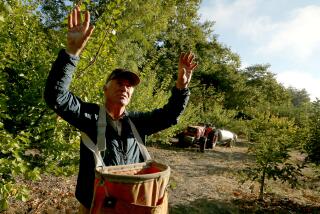Paring Down
When you shop for apples this year, think small. That’s small as in the California crop and small as in the size that’s the best buy.
After initially predicting a total California harvest of 316 million pounds of apples, the industry has lowered its sights to 296 million pounds, a decrease of 6%. That means the harvest is roughly comparable in size to last year’s storm-damaged crop, when torrential spring rains played havoc with new fruit.
There’s a difference this year, though, one that might provide some good buys for smart shoppers.
Last year’s trouble came early, thinning fruit from trees but encouraging those apples that remained to grow bigger. This year’s problems came later, in the form of extended heat throughout the San Joaquin Valley during prime growing. As a result, there aren’t really that many fewer apples than last year, it’s just that they’re smaller (hence the decreased total weight).
The moral of the story is, if you want those big, shiny teacher’s-desk apples this year, you’re going to have to pay a premium. On the other hand, if you’re willing to settle for something a little smaller, you can clean up.
The biggest Granny Smith apples offered wholesale (roughly two apples to the pound) are selling at nearly a 40% premium over the same weight of smaller apples (roughly three to a pound). Look for good buys also in those plastic bags of apples--they’ll be smaller too.
This is true mainly for California apples. Washington, which produces the lion’s share of the U.S. harvest, had a great year, up more than 10% from its five-year average. (To put the Washington harvest in perspective, just the increase from last year to this season would rank fourth among all American states.)
And with the main Washington varieties--Golden and Red Delicious--the price spread from big to small is much less. Of course, that will be true of most of the apples you see in the stores. Those two varieties account for well over half of the fresh apples sold in the United States.



